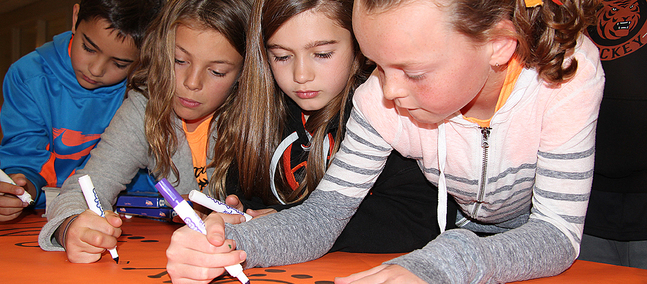October was Bullying Prevention Month
Posted on: Nov 7, 2017

October was National Bullying Prevention Month. Each year Delano Elementary School students are taught how to know, recognize, and handle bullying in different situations.
Staff members help students understand different kinds of bullying and the role of the bystander, and encourage students to report bullying. Overall, it is important for teachers, paraprofessionals, students, and parents to work together to eliminate bullying. The following will explain what bullying is and what family members can do to help.
What is bullying?
According to the United States Health Department’s bullying program, Stop Bullying Now, bullying happens when someone hurts or scares another person on purpose and the person being bullied has a hard time defending himself or herself.
According to the program, examples of bullying include:
• Punching, shoving and other acts that hurt people physically
• Spreading harmful rumors about others
• Keeping certain people out of a group
• Getting one group of people to gang up on others
• Teasing people in a mean way.
Cyberbullying
Bullying can also happen online. Cyberbullying is when children or teens bully each other using the internet, cell phones, or other technology.
This can include:
• Sending mean texts, emails or instant messages
• Posting nasty pictures or messages about others
• Using someone else’s username to spread rumors.
Know the signs
Bullying can be a tough thing to deal with, especially if it is your child who is being bullied. If you’re a parent concerned about bullying, it’s important to recognize the signs and know what you can do to help.
According to the Stop Bullying Now program, signs your child might be getting bullied include:
• Fear or reluctance to go to school in the morning, or complaining repeatedly of headaches or stomach pains
• Sad or depressed emotions, or unexpected mood shifts, irritability and sudden outbursts of temper
• Bad dreams or crying while asleep
• An appearance of social isolation with few – if any – real friends. This student may rarely be invited to parties or to the homes of other kids. A fear of rejection may lead a student to shun others.
• Loss of interest in school work and declining grades.
How can family help?
To help children overcome bullying, parents should:
• Learn as much as you can about bullying among children and youth
• Talk with children in your family about bullying and your expectations about their behavior
• Be watchful for possible signs of bullying among children in your family
• Take immediate action if you suspect bullying
• Work with school personnel and other adults in your community to prevent and reduce bullying.
Making it end
Even though bullying has been in schools for decades, it is important to change the trend and do what we can to eliminate it. There is a lot of research that indicates severe bullying can lead to negative outcomes later in life. Teachers, students and parents need to work together to put an end to bullying and provide a safe learning environment for all children.
For more information on bullying, go to www.stopbullying.gov.
If you know of an instance when your child was bullied, you can report the incident at http://www.delano.k12.mn.us/elementary-school/information/des-bully-report.